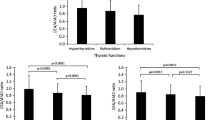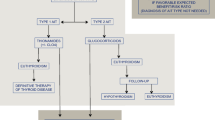Abstract
Background The incidence and risk factors of amiodarone-induced thyroid dysfunction are variable in the literature. Objective The aim of this study was to investigate the clinical and biochemical features and risk factors of amiodarone-induced thyroid dysfunction in Taiwan. Setting This study was conducted at a tertiary referral center for arrhythmia. Method Retrospective analysis of patients treated with amiodarone during the years 2008–2009 was performed. Main outcome measure Incidence and risk factors of amiodarone-induced thyrotoxicosis (AIT) and amiodarone-induced hypothyroidism (AIH) were assessed. Results Of the 527 patients, 437 (82.9 %) remained euthyroid, 21 (4.0 %) developed AIT, and 69 (13.1 %) were affected with AIH. In univariate analysis, AIT was associated with younger age, and the risk factors for AIH included older age, higher baseline thyroid stimulating hormone (TSH) titer, lower baseline free T4 level, lower cumulative amiodarone dosage, and shorter amiodarone treatment duration. Cox regression analysis was performed to determine the different risk categories in the elderly population of age 65–74 (young-old), 75–84 (old-old), and ≥85 years old (oldest-old). Additionally increased risk of AIH was found in the groups of old-old (HR 2.09, 95 % CI 1.11–3.96) and oldest-old (HR 2.57, 95 % CI 1.21–4.75). In the multivariate analysis of risk factors for AIH, baseline TSH level (HR 1.38, 95 % CI 1.12–1.70) and cumulative amiodarone dosage (HR 0.95, 95 % CI 0.93–0.97) remained statistically significant. Conclusion AIH was much more common than AIT in Taiwan, an area with sufficient iodine intake. Higher baseline TSH level was the predominant independent risk factor for the development of AIH.

Similar content being viewed by others

References
Vorperian VR, Havighurst TC, Miller S, January CT. Adverse effects of low dose amiodarone: a meta-analysis. J Am Coll Cardiol. 1997;30:791–8.
Han TS, Williams GR, Vanderpump MP. Benzofuran derivatives and the thyroid. Clin Endocrinol. 2009;70:2–13.
Cohen-Lehman J, Dahl P, Danzi S, Klein I. Effects of amiodarone therapy on thyroid function. Nat Rev Endocrinol. 2010;6:34–41.
Sidhu J, Jenkins D. Men are at increased risk of amiodarone-associated thyrotoxicosis in the UK. QJM. 2003;96:949–50.
Schaan BD, Cunha CP, Francisconi A, Zottis B, Brum G, Bruch RS, et al. Amiodarone-induced thyroid dysfunction in a tertiary center in south Brazil. Arq Bras Endocrinol Metabol. 2005;49:916–22.
Lee KF, Lee KM, Fung TT. Amiodarone-induced thyroid dysfunction in the Hong Kong Chinese population. Hong Kong Med J. 2010;16:434–9.
Ahmed S, Van Gelder IC, Wiesfeld AC, Van Veldhuisen DJ, Links TP. Determinants and outcome of amiodarone-associated thyroid dysfunction. Clin Endocrinol. 2011;75:388–94.
Stan MN, Ammash NM, Warnes CA, Brennan MD, Thapa P, Nannenga MR, et al. Body mass index and the development of amiodarone-induced thyrotoxicosis in adults with congenital heart disease-A cohort study. Int J Cardiol. 2013;167:821–6.
Zosin I, Balas M. Amiodarone-induced thyroid dysfunction in an iodine-replete area: epidemiological and clinical data. Endokrynol Pol. 2012;63:2–9.
Martino E, Aghini-Lombardi F, Mariotti S, Bartalena L, Lenziardi M, Ceccarelli C, et al. Amiodarone iodine-induced hypothyroidism: risk factors and follow-up in 28 cases. Clin Endocrinol. 1987;26:227–37.
Trip MD, Wiersinga W, Plomp TA. Incidence, predictability, and pathogenesis of amiodarone-induced thyrotoxicosis and hypothyroidism. Am J Med. 1991;91:507–11.
Aleksic Z, Aleksic A. Incidence of amiodarone-induced thyroid dysfunction and predictive factors for their occurrence. Med Pregl. 2011;64:533–8.
Martino E, Aghini-Lombardi F, Bartalena L, Grasso L, Loviselli A, Velluzzi F, et al. Enhanced susceptibility to amiodarone-induced hypothyroidism in patients with thyroid autoimmune disease. Arch Intern Med. 1994;154:2722–6.
Martino E, Safran M, Aghini-Lombardi F, Rajatanavin R, Lenziardi M, Fay M, et al. Environmental iodine intake and thyroid dysfunction during chronic amiodarone therapy. Ann Intern Med. 1984;101:28–34.
Thorne SA, Barnes I, Cullinan P, Somerville J. Amiodarone-associated thyroid dysfunction: risk factors in adults with congenital heart disease. Circulation. 1999;100:149–54.
Bouvy ML, Heerdink ER, Hoes AW, Leufkens HG. Amiodarone-induced thyroid dysfunction associated with cumulative dose. Pharmacoepidemiol Drug Saf. 2002;11:601–6.
Lin HD, Lo JG, Ching KN. Amount of urinary iodine excretion in residents of Taipei City: a hospital-based study. J Chin Med Assoc. 1991;48:20–4.
Hofmann A, Nawara C, Ofluoglu S, Holzmannhofer J, Strohmer B, Pirich C. Incidence and predictability of amiodarone-induced thyrotoxicosis and hypothyroidism. Wien Klin Wochenschr. 2008;120:493–8.
Diehl LA, Romaldini JH, Graf H, Bartalena L, Martino E, Albino CC, et al. Management of amiodarone-induced thyrotoxicosis in Latin America: an electronic survey. Clin Endocrinol. 2006;65:433–8.
Tanda ML, Piantanida E, Lai A, Liparulo L, Sassi L, Bogazzi F, et al. Diagnosis and management of amiodarone-induced thyrotoxicosis: similarities and differences between North American and European thyroidologists. Clin Endocrinol. 2008;69:812–8.
Bartalena L, Wiersinga WM, Tanda ML, Bogazzi F, Piantanida E, Lai A, et al. Diagnosis and management of amiodarone-induced thyrotoxicosis in Europe: results of an international survey among members of the European Thyroid Association. Clin Endocrinol. 2004;61:494–502.
Bogazzi F, Bartalena L, Gasperi M, Braverman LE, Martino E. The various effects of amiodarone on thyroid function. Thyroid. 2001;11:511–9.
Bongard V, Marc D, Philippe V, Jean-Louis M, Maryse LM. Incidence rate of adverse drug reactions during long-term follow-up of patients newly treated with amiodarone. Am J Ther. 2006;13:315–9.
Batcher EL, Tang XC, Singh BN, Singh SN, Reda DJ, Hershman JM, et al. Thyroid function abnormalities during amiodarone therapy for persistent atrial fibrillation. Am J Med. 2007;120:880–5.
Vanderpump MP, Tunbridge WM, French JM, Appleton D, Bates D, Clark F, et al. The incidence of thyroid disorders in the community: a twenty-year follow-up of the Whickham Survey. Clin Endocrinol. 1995;43:55–68.
Walsh JP, Bremner AP, Feddema P, Leedman PJ, Brown SJ, O’Leary P. Thyrotropin and thyroid antibodies as predictors of hypothyroidism: a 13-year, longitudinal study of a community-based cohort using current immunoassay techniques. J Clin Endocrinol Metab. 2010;95:1095–104.
Asvold BO, Vatten LJ, Midthjell K, Bjoro T. Serum TSH within the reference range as a predictor of future hypothyroidism and hyperthyroidism: 11-year follow-up of the HUNT Study in Norway. J Clin Endocrinol Metab. 2012;97:93–9.
Huang CC, Chen YC, Chen LK, Hwang SJ, Lin HD. Relationship between age and serum thyrotropin among asymptomatic older people in Taiwan. Arch Gerontol Geriatr. 2010;51:117–20.
Gheri RG, Pucci P, Falsetti C, Luisi ML, Cerisano GP, Gheri CF, et al. Clinical, biochemical and therapeutical aspects of amiodarone-induced hypothyroidism (AIH) in geriatric patients with cardiac arrhythmias. Arch Gerontol Geriatr. 2004;38:27–36.
Maselli M, Inelmen EM, Giantin V, Manzato E. Hypothyroidism in the elderly: diagnostic pitfalls illustrated by a case report. Arch Gerontol Geriatr. 2012;55:82–4.
Burgess C, Blaikie A, Ingham T, Robinson G, Narasimhan S. Monitoring the use of amiodarone: compliance with guidelines. Intern Med J. 2006;36:289–93.
Raebel MA, Carroll NM, Simon SR, Andrade SE, Feldstein AC, Lafata JE, et al. Liver and thyroid monitoring in ambulatory patients prescribed amiodarone in 10 HMOs. J Manag Care Pharm. 2006;12:656–64.
Funding
This study was partly supported by research Grants V100B-039, V101B-023, V102B-048 to L.Y.L. and V100A-013 to P.J.C from Taipei Veterans General Hospital, Taipei, Taiwan.
Conflicts of interest
None.
Author information
Authors and Affiliations
Corresponding author
Rights and permissions
About this article
Cite this article
Huang, CJ., Chen, PJ., Chang, JW. et al. Amiodarone-induced thyroid dysfunction in Taiwan: a retrospective cohort study. Int J Clin Pharm 36, 405–411 (2014). https://doi.org/10.1007/s11096-013-9910-9
Received:
Accepted:
Published:
Issue Date:
DOI: https://doi.org/10.1007/s11096-013-9910-9



